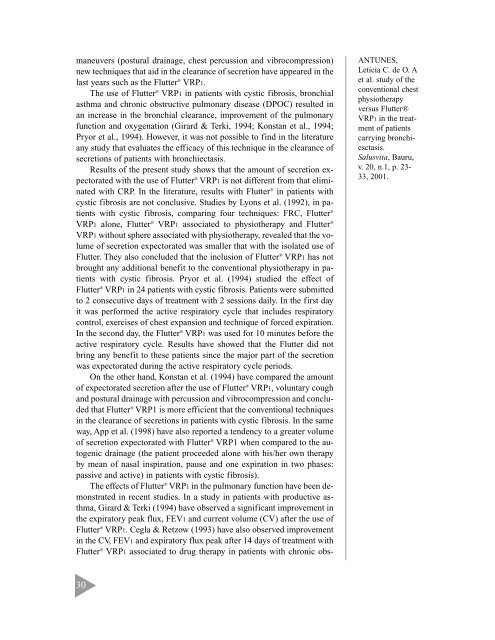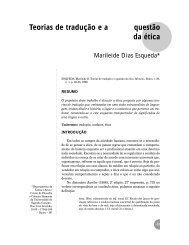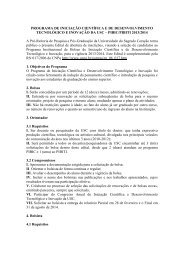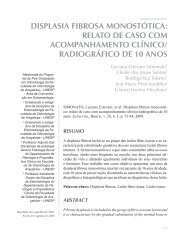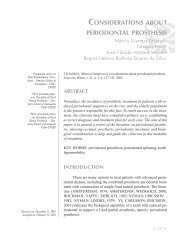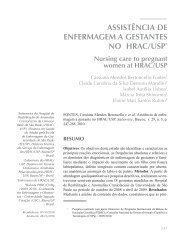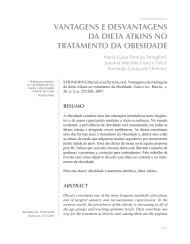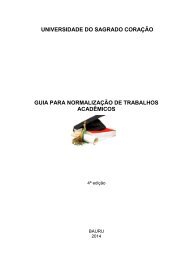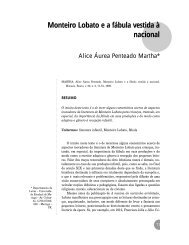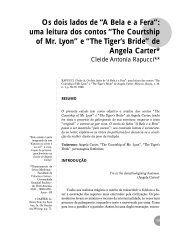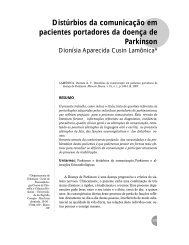ciências biológicas e da saúde - USC
ciências biológicas e da saúde - USC
ciências biológicas e da saúde - USC
- No tags were found...
You also want an ePaper? Increase the reach of your titles
YUMPU automatically turns print PDFs into web optimized ePapers that Google loves.
maneuvers (postural drainage, chest percussion and vibrocompression)new techniques that aid in the clearance of secretion have appeared in thelast years such as the Flutter ® VRP1.The use of Flutter ® VRP1 in patients with cystic fibrosis, bronchialasthma and chronic obstructive pulmonary disease (DPOC) resulted inan increase in the bronchial clearance, improvement of the pulmonaryfunction and oxygenation (Girard & Terki, 1994; Konstan et al., 1994;Pryor et al., 1994). However, it was not possible to find in the literatureany study that evaluates the efficacy of this technique in the clearance ofsecretions of patients with bronchiectasis.Results of the present study shows that the amount of secretion expectoratedwith the use of Flutter ® VRP1 is not different from that eliminatedwith CRP. In the literature, results with Flutter ® in patients withcystic fibrosis are not conclusive. Studies by Lyons et al. (1992), in patientswith cystic fibrosis, comparing four techniques: FRC, Flutter ®VRP1 alone, Flutter ® VRP1 associated to physiotherapy and Flutter ®VRP1 without sphere associated with physiotherapy, revealed that the volumeof secretion expectorated was smaller that with the isolated use ofFlutter. They also concluded that the inclusion of Flutter ® VRP1 has notbrought any additional benefit to the conventional physiotherapy in patientswith cystic fibrosis. Pryor et al. (1994) studied the effect ofFlutter ® VRP1 in 24 patients with cystic fibrosis. Patients were submittedto 2 consecutive <strong>da</strong>ys of treatment with 2 sessions <strong>da</strong>ily. In the first <strong>da</strong>yit was performed the active respiratory cycle that includes respiratorycontrol, exercises of chest expansion and technique of forced expiration.In the second <strong>da</strong>y, the Flutter ® VRP1 was used for 10 minutes before theactive respiratory cycle. Results have showed that the Flutter did notbring any benefit to these patients since the major part of the secretionwas expectorated during the active respiratory cycle periods.On the other hand, Konstan et al. (1994) have compared the amountof expectorated secretion after the use of Flutter ® VRP1, voluntary coughand postural drainage with percussion and vibrocompression and concludedthat Flutter ® VRP1 is more efficient that the conventional techniquesin the clearance of secretions in patients with cystic fibrosis. In the sameway, App et al. (1998) have also reported a tendency to a greater volumeof secretion expectorated with Flutter ® VRP1 when compared to the autogenicdrainage (the patient proceeded alone with his/her own therapyby mean of nasal inspiration, pause and one expiration in two phases:passive and active) in patients with cystic fibrosis).The effects of Flutter ® VRP1 in the pulmonary function have been demonstratedin recent studies. In a study in patients with productive asthma,Girard & Terki (1994) have observed a significant improvement inthe expiratory peak flux, FEV1 and current volume (CV) after the use ofFlutter ® VRP1. Cegla & Retzow (1993) have also observed improvementin the CV, FEV1 and expiratory flux peak after 14 <strong>da</strong>ys of treatment withFlutter ® VRP1 associated to drug therapy in patients with chronic obs-ANTUNES,Letícia C. de O. Aet al. study of theconventional chestphysiotherapyversus Flutter®VRP1 in the treatmentof patientscarrying bronchiesctasis.Salusvita, Bauru,v. 20, n.1, p. 23-33, 2001.30


